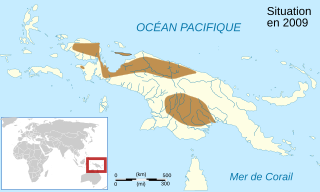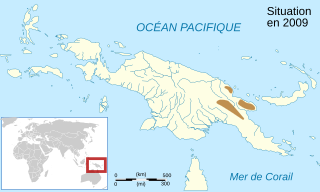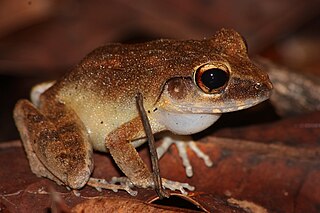
Nyctimystes daymani, also known as the Dayman big-eyed treefrog, is a species of frog in the family Pelodryadidae, also treated as the subfamily Pelodryadinae in the family Hylidae. It is endemic to Papua New Guinea and known from its type locality, Mount Dayman in the Milne Bay Province, easternmost mainland New Guinea. Records from further west are uncertain.
Nyctimystes fluviatilis, also known as the Indonesian big-eyed tree frog, is a species of frog in the family Pelodryadidae, also treated as the subfamily Pelodryadinae in the family Hylidae. It is endemic to New Guinea and is known from Idenburg River and Wapoga River in Papua province, Indonesia, and from the Torricelli Mountains in the East Sepik Province and Kavorabip in the Western Province, both in the western Papua New Guinea.
Nyctimystes narinosus, the common big-eyed treefrog, is a species of frog in the family Pelodryadidae, or alternatively, subfamily Pelodryadinae in the family Hylidae. It is endemic to New Guinea and occurs in the Wahgi-Sepik Dividing Range and the Schrader Mountains, on both sides of the border between Papua (Indonesia) and Papua New Guinea. There is, however, some uncertainty about the western limit of this species. Despite its vernacular name, Nyctimystes narinosus is not a common species.
Nyctimystes trachydermis, also known as the Morobe big-eyed treefrog, is a species of frog in the family Pelodryadidae, or alternatively, subfamily Pelodryadinae in the family Hylidae. It is endemic to Papua New Guinea and occurs in the mountains of southern eastern New Guinea. Its type locality is Gapaia Creek, at 1,280 m (4,200 ft) asl between Garaina and Saureli, in the Morobe Province. The specific name trachydermis means "rough skinned", derived from the Greek words trachys and derma.
Choerophryne swanhildae is a species of frog in the family Microhylidae. It is endemic to Papua New Guinea and is known from the Hagen and Kubor ranges.
Asterophrys leucopus is a species of frog in the family Microhylidae. It is endemic to northwestern Papua New Guinea where it is known from three locations: Stolle Mountain in the Sandaun Province—its type locality, and Hunstein Mountains in the East Sepik Province and the Bewani Mountains in the West Sepik Province.

Asterophrys turpicola is a species of frog in the family Microhylidae. It is widespread in New Guinea and found in both West Papua (Indonesia) and Papua New Guinea, although it appears to be absent from the eastern half of Papua New Guinea. It also occurs on the island of Yapen, off the north-western coast of New Guinea. The species is known for its aggressive behaviour: it can attack and bite viciously.
Austrochaperina blumi is a species of frog in the family Microhylidae. It is endemic to New Guinea and known from the northern slopes of the New Guinean Central Range in Western New Guinea (Indonesia), and from the Bewani, Torricelli, and Hunstein Mountains in Papua New Guinea. The specific name blumi honors J. Paul Blum, the herpetologist who collected the type series. Common name Kosarek land frog has been proposed for it.

Cophixalus pipilans is a species of frog in the family Microhylidae. It is endemic to northern mainland Papua New Guinea and occurs between Lae and the Adelbert Mountains. The specific name pipilans is derived from the Latin verb pipilio and means "peeping". Common name Sempi rainforest frog has been coined for this species.
Cophixalus riparius is a species of frog in the family Microhylidae. It is endemic to Papua New Guinea and occurs in the New Guinea Highlands in Madang, Southern Highlands, and Western Highlands provinces southeastward to the Morobe Province. The specific name riparius refers to the creek-side habitat from which many specimens in the type series were collected. Common name Wilhelm rainforest frog has been coined for this species.

Cophixalus shellyi is a species of frog in the family Microhylidae. It is endemic to Papua New Guinea and occurs in the New Guinea Highlands as well as in the Adelbert Range and on the Huon Peninsula. The specific name shellyi honors Father O. Shelly, an American missionary and former professor in mathematics who collected the type series.
Sphenophryne rubra is a species of frog in the family Microhylidae. It is endemic to New Guinea and is only known from the Kubor and Bismarck Ranges in the New Guinea Highlands, Papua New Guinea. The habitat and ecology of this species known from very few specimens are unknown.

Sphenophryne similis is a species of frog in the family Microhylidae. It is endemic to New Guinea and is only known from its type locality in the Owen Stanley Range, Northern Province, Papua New Guinea.

Mantophryne louisiadensis is a species of frog in the family Microhylidae. It is endemic to Rossel Island, a part of the Louisiade Archipelago in the Milne Bay Province of Papua New Guinea. Common name Louisiade archipelago frog has been proposed for this species. Mantophryne axanthogaster from the neighboring Sudest Island was formerly included in it.
Oreophryne biroi is a species of frog in the family Microhylidae. It is endemic to New Guinea and occurs on the north coast from Madang Province in Papua New Guinea to the Cyclops Mountains in Papua province, Western New Guinea (Indonesia). The specific name biroi honours Lajos Bíró, a Hungarian zoologist and ethnographer who collected the holotype. Common name New Guinea cross frog has been coined for it.
Sphenophryne crassa is a species of frog in the family Microhylidae. It is endemic to eastern New Guinea and is known from the Mount Dayman and Mount Simpson in the Owen Stanley Range, Papua New Guinea. Common name Papua land frog has been proposed for it.
Mantophryne menziesi, commonly known as the Iarowari School frog, is a species of frog in the family Microhylidae. It is endemic to New Guinea and is only known from near Port Moresby, Papua New Guinea. The actual limits of its distribution are poorly known.

Cornufer papuensis is a species of frog in the family Ceratobatrachidae. It is found in the northern parts of New Guinea and in many surrounding islands, including the Bismarck Archipelago, D'Entrecasteaux Islands, Trobriand Islands, and Maluku Islands including Sula Islands and Seram Island (Indonesia). Common name Papua wrinkled ground frog has been coined for the species.
Cornufer punctatus, commonly known as the dotted wrinkled ground frog, is a species of frog in the family Ceratobatrachidae. It is endemic to Western New Guinea (Indonesia) and occurs in the Arfak and Wondiwoi Mountains in the Guinean mainland well as on some adjacent islands.
Asterophrys pullifer is a species of frog in the family Microhylidae. It is endemic to New Guinea and known from the Wondiwoi Mountains at the base of the Wandammen Peninsula in Western New Guinea (Indonesia), and from the Mount Shungol and Bowutu Mountains in Papua New Guinea.





